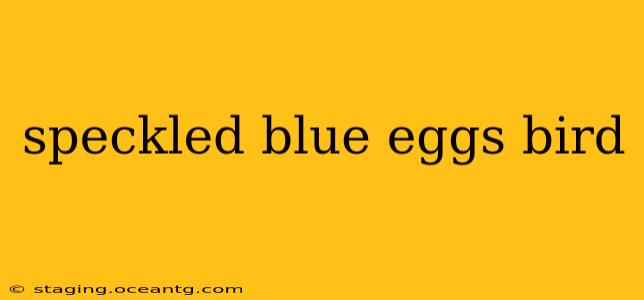The sight of a speckled blue egg nestled in a bird's nest is captivating. The delicate blue, often speckled with brown or other colors, hints at the mystery of the bird that laid it. But which feathered friend is responsible for this stunning creation? Identifying the bird behind these beautiful blue eggs requires a bit of detective work, but with a few clues, you can often narrow down the possibilities. This guide will help you unravel the mystery surrounding these captivating speckled blue eggs.
What Birds Lay Specked Blue Eggs?
Many bird species lay eggs with a blue hue, ranging from a pale sky blue to a deep, vibrant azure. The speckling can vary significantly in color and density, adding another layer of complexity to identification. Some common North American birds known for laying speckled blue eggs include:
- Eastern Bluebirds: These iconic birds lay a beautiful pale blue egg, often lightly speckled with brown. The speckling is usually less prominent than in some other species.
- Robin (American Robin): While often associated with a solid blue-green egg, some robins may lay eggs with faint speckling.
- Bluebirds (various species): Several bluebird species lay eggs with a range of blue shades and speckling patterns. The specific pattern can depend on the individual bird and its geographical location.
- Certain Thrush species: Various thrush species across the globe display a preference for blue and blue-green eggs, often with varying degrees of speckling.
What Determines Egg Color and Speckling?
The color and patterning of bird eggs are fascinating and complex. While the exact mechanisms are still being researched, it is believed that:
- Pigments: The color of the eggshell is primarily determined by the deposition of two pigments during egg formation: biliverdin (which creates blue and green hues) and protoporphyrin (which contributes to red and brown colors).
- Genetic Factors: The specific hues and patterns of speckling are often genetically determined within a species. Variations in these genes can lead to differences in egg coloration within the same population.
- Environmental Influences: While less significant, factors like diet and overall health of the female bird may also subtly affect egg color.
How Can I Identify the Bird from Just the Egg?
Identifying the bird based solely on the egg can be challenging, even for experienced bird watchers. Several factors make this difficult:
- Variation within species: Eggs from the same species can vary in color and speckling.
- Similar egg colors across species: Different bird species can lay eggs with strikingly similar colors.
- Lack of other clues: Without observing the nest, location, and other characteristics, identification is incredibly difficult.
Factors to Consider When Trying to Identify the Bird:
- Location: Where was the egg found? This significantly narrows down the possibilities.
- Nest type: The type of nest (cup nest, cavity nest, etc.) offers valuable clues.
- Egg Size and Shape: While subtle, size and shape can provide hints.
What Do the Colors and Patterns of Eggs Mean?
The color and pattern of bird eggs have been linked to various factors, including camouflage and thermoregulation:
- Camouflage: Speckling can help camouflage the eggs, making them less visible to predators.
- Thermoregulation: The color and texture of the eggshell might also play a role in regulating the temperature of the eggs during incubation.
Are Specked Blue Eggs Rare?
The rarity of speckled blue eggs depends on the species and location. While some species commonly lay speckled blue eggs, others do not. The overall frequency of seeing these eggs depends on your geographic location and the prevalence of the birds that lay them in your area.
Ultimately, observing the entire nesting context is key to accurate identification. Combining the information gathered from the egg itself with the nest location, nest type, and other clues in the surrounding environment will significantly improve your chances of successfully identifying the bird responsible for those beautiful speckled blue eggs.
